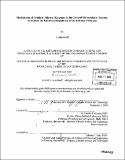Modulation of cochlear afferent response by the lateral olivocochlear system : activation via electrical stimulation of the inferior colliculus
Author(s)
Groff, J. Alan (John Alan), 1975-
DownloadFull printable version (5.823Mb)
Other Contributors
Harvard University--MIT Division of Health Sciences and Technology.
Advisor
M. Charles Liberman.
Terms of use
Metadata
Show full item recordAbstract
The olivocochlear (OC) efferent innervation of the mammalian inner ear consists of two subdivisions, medial (MOC) and lateral (LOC), with peripheral terminations on outer hair cells and cochlear afferent terminals, respectively. The cochlear effects of electrically activating MOC efferents are well known: the MOC efferents suppress cochlear responses by reducing outer hair cells' contribution to cochlear amplification. In contrast, LOC peripheral effects are unknown, because their unmyelinated axons are difficult to stimulate. To overcome the difficulty of directly activating the LOC system, stimulating electrodes were placed in the inferior colliculus (IC) to activate the LOC system indirectly, while recording cochlear responses bilaterally from anesthetized guinea pigs. Neural potentials and outer hair cell based potentials were recorded before and after IC stimulation for tens of minutes. Stimulation at some IC sites produced novel cochlear effects attributable to activation of the LOC system: long-lasting (1-20 min) enhancement or suppression of cochlear neural responses (compound action potentials (CAP) and round window noise), without changes in cochlear responses dominated by outer hair cells (otoacoustic emissions and cochlear microphonics). These novel effects also differed from classic MOC effects in their laterality and their dependence on level and frequency of the acoustic stimulus. The changes in CAP are well described as "constant %" increases or decreases. These effects disappeared upon sectioning the entire OC bundle, but not after selective lesioning of the MOC tracts or the cochlea's autonomic innervation. Based on this evidence, I conclude that the LOC pathway comprises two functional subdivisions capable of inducing (cont.) slow increases or decreases in response magnitudes in the auditory nerve. The LOC system originates in the lateral superior olive (LSO), which is the ascending nucleus where sound localization is computed. Such a system may be useful in maintaining accurate binaural comparisons necessary for sound localization in the face of slow changes in interaural sensitivity.
Description
Thesis (Ph. D.)--Harvard-MIT Division of Health Sciences and Technology, February 2004. Includes bibliographical references (p. 96-103).
Date issued
2004Department
Harvard University--MIT Division of Health Sciences and TechnologyPublisher
Massachusetts Institute of Technology
Keywords
Harvard University--MIT Division of Health Sciences and Technology.